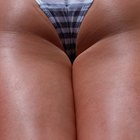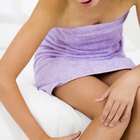Waxing is very effective for temporary hair removal. Unlike shaving, which cuts the hair off at the skin, waxing grabs hair from the root, leaving the skin smooth for weeks at a time. Unfortunately, common side effects of waxing can include redness, inflammation of the skin, rashes and bumps. These will typically subside within a few hours, but meanwhile, you can soothe the skin and speed healing.
Waxing 101
The waxing process is simple and can be done either at home or a salon. The most common method involves warm wax is placed directly onto the skin in the direction of the hair growth. A fabric strip is placed on the wax and is quickly pulled in the opposite direction of hair growth. Hair is removed straight from the root. The process can be painful but wax enthusiasts find that it's worth the suffering since regrowth takes longer and stumble is not an issue.
Before and After
Prepping skin for waxing is key to reducing irritation. So it's important to exfoliate beforehand. Exfoliation can help get rid of dead skin cells and prevent inflamed ingrown hairs. Exfoliate using a special brush or scrubs designed specifically for this purpose. Any exfoliation should be done at least 24 hours before waxing so that skin is not too sensitive for the wax.
Additionally, many post-waxing treatments can prevent redness and bumps while soothing the skin.
- Apply an ice pack or a cold, wet cloth to waxed area for 10 to 15 minutes to alleviate redness.
- Apply a layer of soothing aloe vera gel to the waxed area. You can ever keep the gel in the fridge to make it cold.
- Massage grapeseed oil onto your skin for pain relief.
- Triple antibiotic ointments, formulated to speed the healing of cuts and scrapes, can do the same for waxed skin. Just follow the instructions on the packaging for best results.
Preventing Bumps
To prevent bumps or a breakout, you can apply antiseptics to the waxed area. Tea tree oil is a natural antiseptic that can prevent ingrown hairs. You can also wash the area with salicylic acid cleansers to prevent flare-ups and to keep skin in the area chemically exfoliated.
Related Articles

How to Prevent Breakouts After Waxing

How to Keep From Getting Ingrown Armpit ...

How to Remove Veet Wax

How to Stop Stubble Itch

How to Heal an Inflamed Bikini Area

How to Remove Perianal Hair

How to Heal a Bikini Razor Burn

How Long Should You Grow Out Leg Hair ...

Hair Removal With Papaya

Surgi-Wax Directions

How Do I Reduce Pain When Plucking Leg ...

How to Treat an Ingrown Eyebrow Hair

What Is a Good Way to Get Rid of Hair ...

How to Make a Homemade Facial Hair ...

How to Get Rid of Irritation From ...

How to Clear Up Red Bikini Line Bumps

Does Shea Butter Help Razor Bumps?

How to Treat Eyebrow Wax Burns

How to Cure Razor Burn on a Woman's ...

How to Use GiGi All Purpose Honee Wax
References
Writer Bio
Regina Olsen holds a Master of Arts in journalism. She has written for many publications, including Textile View magazine. Olsen has also ghostwritten a book about Chinese fashion, published in 2009.